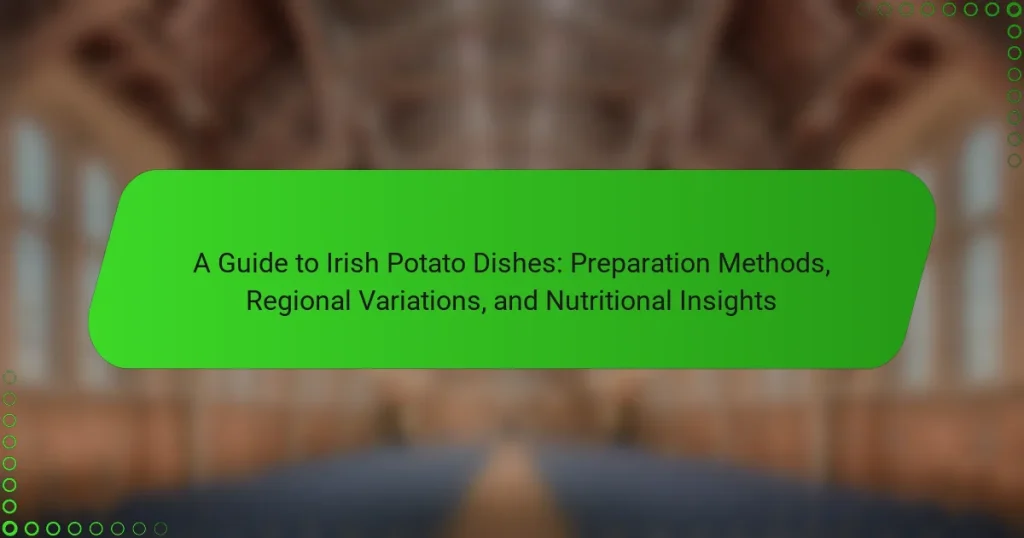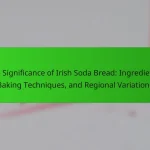Irish potato dishes are a cornerstone of Irish cuisine, known for their simplicity, heartiness, and versatility. This guide covers various preparation methods, such as boiling, mashing, and baking, while highlighting traditional recipes like colcannon and boxty that utilize regional ingredients. Nutritional insights reveal that these dishes are rich in carbohydrates, dietary fiber, and essential vitamins and minerals, contributing to overall health. The article also emphasizes the importance of using fresh, high-quality potatoes and proper cooking techniques to enhance flavor and texture. Additionally, the use of herbs like parsley and chives adds freshness to these beloved dishes, reflecting Ireland’s agricultural heritage.
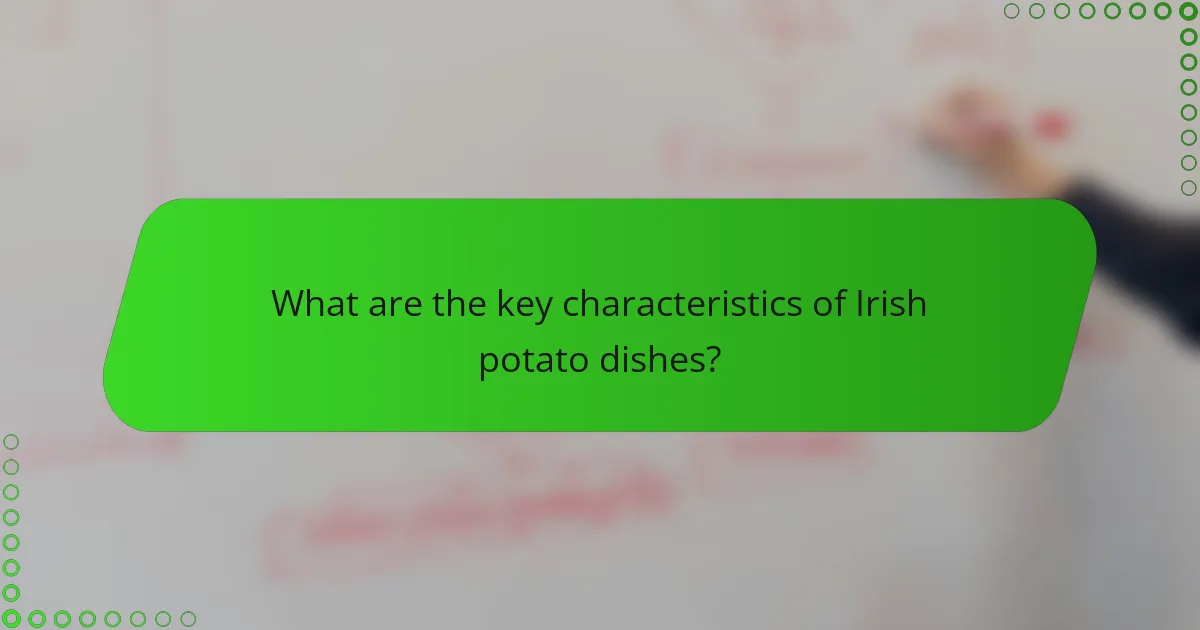
What are the key characteristics of Irish potato dishes?
Irish potato dishes are characterized by their simplicity, heartiness, and versatility. These dishes often use varieties like the Irish Lumper and Rooster potatoes. Common preparation methods include boiling, mashing, and baking. Many dishes feature butter and cream, enhancing their rich flavor. Traditional recipes like colcannon and boxty highlight regional ingredients. The use of herbs like parsley and chives is prevalent for added freshness. Irish potato dishes are often served as side dishes or main courses, reflecting their cultural significance. The emphasis on local produce showcases Ireland’s agricultural heritage.
How are Irish potato dishes traditionally prepared?
Irish potato dishes are traditionally prepared through methods such as boiling, baking, and frying. Boiling is a common technique, where potatoes are peeled, cut, and cooked in salted water until tender. This method is often used for dishes like colcannon and mashed potatoes. Baking involves cooking whole potatoes in their skins until soft, commonly seen in baked potato recipes. Frying is another popular preparation method, used for making dishes like potato cakes and chips. Each method enhances the natural flavor of the potatoes, making them a versatile ingredient in Irish cuisine.
What cooking techniques are commonly used in Irish potato dishes?
Common cooking techniques used in Irish potato dishes include boiling, baking, mashing, and frying. Boiling is a basic method often used for preparing potatoes for dishes like colcannon. Baking is frequently employed for making dishes such as baked potatoes or potato gratin. Mashing is a popular technique for creating creamy mashed potatoes, often served as a side. Frying is used for dishes like potato cakes and chips. Each technique enhances the potatoes’ flavor and texture, making them versatile in Irish cuisine.
What ingredients complement Irish potato dishes?
Butter complements Irish potato dishes. It adds richness and creaminess. Cream is another ingredient that enhances flavor. Chives provide a fresh, onion-like taste. Bacon adds a savory, smoky element. Cheese, especially cheddar, gives a sharp contrast. Herbs like parsley or thyme offer aromatic notes. These ingredients are commonly used in traditional Irish recipes. They elevate the overall taste and texture of potato dishes.
What are the most popular Irish potato dishes?
The most popular Irish potato dishes include colcannon, champ, and boxty. Colcannon is made with mashed potatoes, cabbage, and butter. It has a rich history in Irish cuisine, often served during Halloween. Champ consists of mashed potatoes mixed with scallions and butter. This dish is known for its simplicity and flavor. Boxty is a traditional potato pancake made from grated and mashed potatoes. It is a staple in Irish households, especially in the north. These dishes highlight the versatility of potatoes in Irish cooking.
How is Colcannon made and what are its ingredients?
Colcannon is made by combining mashed potatoes with various ingredients. The primary ingredients include potatoes, cabbage or kale, milk, butter, and salt. First, potatoes are peeled and boiled until tender. Then, they are mashed with milk and butter for creaminess. Chopped cabbage or kale is cooked separately and then mixed into the potatoes. Salt is added to taste, enhancing the dish’s flavor. This traditional Irish dish is often served as a side. Colcannon is known for its comforting texture and rich taste.
What is the significance of Boxty in Irish cuisine?
Boxty is a traditional Irish potato dish significant in Irish cuisine. It is made primarily from grated raw potatoes, flour, baking powder, and buttermilk. Boxty showcases the versatility of potatoes, a staple in Ireland. The dish has regional variations, particularly in County Leitrim and the surrounding areas. It is often served as a side dish or a main course. Historical references to boxty date back to the 18th century, emphasizing its cultural importance. The phrase “Boxty on the griddle, boxty in the pan” highlights its popularity in Irish folklore. Today, boxty remains a beloved comfort food, reflecting Irish heritage and culinary traditions.
How do you prepare Irish Potato Cakes?
To prepare Irish Potato Cakes, start by boiling and mashing potatoes. Use about two cups of cooked potatoes for the recipe. Next, mix in flour, salt, and pepper to form a dough. Shape the dough into small cakes or patties. Heat butter or oil in a frying pan over medium heat. Cook the cakes for about 3-4 minutes on each side until golden brown. Serve hot as a side dish or snack. Irish Potato Cakes are a traditional dish often enjoyed with various toppings.
What regional variations exist in Irish potato dishes?
Irish potato dishes exhibit notable regional variations across Ireland. In the west, particularly in County Kerry, “boxty” is popular. This dish consists of grated raw potatoes mixed with flour, water, and baking powder, then fried. In the north, “champ” is commonly enjoyed. Champ combines mashed potatoes with scallions and butter, offering a creamy texture. The southeast region, especially around Wexford, favors “colcannon.” Colcannon mixes mashed potatoes with cabbage or kale, often served during Halloween. Each regional dish reflects local ingredients and culinary traditions, showcasing the versatility of potatoes in Irish cuisine.
How do potato dishes differ between Northern and Southern Ireland?
Potato dishes differ significantly between Northern and Southern Ireland. In Northern Ireland, traditional dishes often include champ, which is mashed potatoes mixed with scallions. Additionally, potato farls, which are fried potato cakes, are a common breakfast item. In contrast, Southern Ireland features dishes like colcannon, a mix of mashed potatoes and cabbage or kale. The southern region also emphasizes the use of creamy potatoes in dishes such as boxty, a type of potato pancake. Historical influences shape these differences, with Northern Ireland’s cuisine reflecting British traditions and Southern Ireland’s cuisine influenced by its agricultural practices.
What unique potato dishes are found in rural Irish communities?
Unique potato dishes in rural Irish communities include colcannon, champ, and boxty. Colcannon is a traditional dish made from mashed potatoes mixed with cabbage or kale. This dish often features butter and cream for added richness. Champ consists of mashed potatoes blended with scallions and butter. It is a popular comfort food in various regions. Boxty is a type of potato pancake made from grated and mashed potatoes, flour, and baking powder. It is typically fried until crispy. These dishes reflect the agricultural heritage and local ingredients of rural Ireland.
How do cultural influences shape Irish potato dishes?
Cultural influences shape Irish potato dishes through historical, social, and culinary traditions. The potato was introduced to Ireland in the late 16th century and became a staple food. This shift was significantly influenced by the Great Famine in the 19th century, which led to the development of various potato-based dishes as a means of survival. Traditional recipes like colcannon and boxty reflect regional variations and local ingredients. Additionally, Irish immigrants brought their potato dishes to other countries, further evolving these recipes. Modern influences, including globalization, have introduced new flavors and techniques to traditional Irish potato cuisine.
What historical events have impacted the evolution of Irish potato dishes?
The evolution of Irish potato dishes has been significantly impacted by historical events such as the Great Famine. The Great Famine occurred between 1845 and 1852. It was caused by a potato blight that devastated crops. This led to mass starvation and emigration. As a result, potatoes became a symbol of sustenance and survival in Ireland.
Additionally, the introduction of the potato to Ireland in the late 16th century transformed agriculture. Potatoes provided a reliable food source for the population. Over time, various cooking methods developed, including boiling, baking, and frying. The cultural significance of potatoes influenced traditional recipes and regional variations.
The impact of British colonial policies also shaped potato consumption. Land ownership and farming practices were altered, affecting access to food. These historical events collectively influenced the preparation and appreciation of Irish potato dishes.
How do seasonal ingredients affect the preparation of Irish potato dishes?
Seasonal ingredients significantly influence the preparation of Irish potato dishes. The availability of fresh, local produce enhances flavor and nutritional value. For example, spring brings young, tender potatoes that are ideal for salads. In contrast, winter yields heartier varieties suited for mashes and stews. Seasonal herbs and vegetables, such as leeks in winter and peas in summer, complement potato dishes. This seasonal approach aligns with traditional Irish cooking, emphasizing local and seasonal produce. Historical practices in Ireland show that using seasonal ingredients leads to more vibrant and authentic flavors.
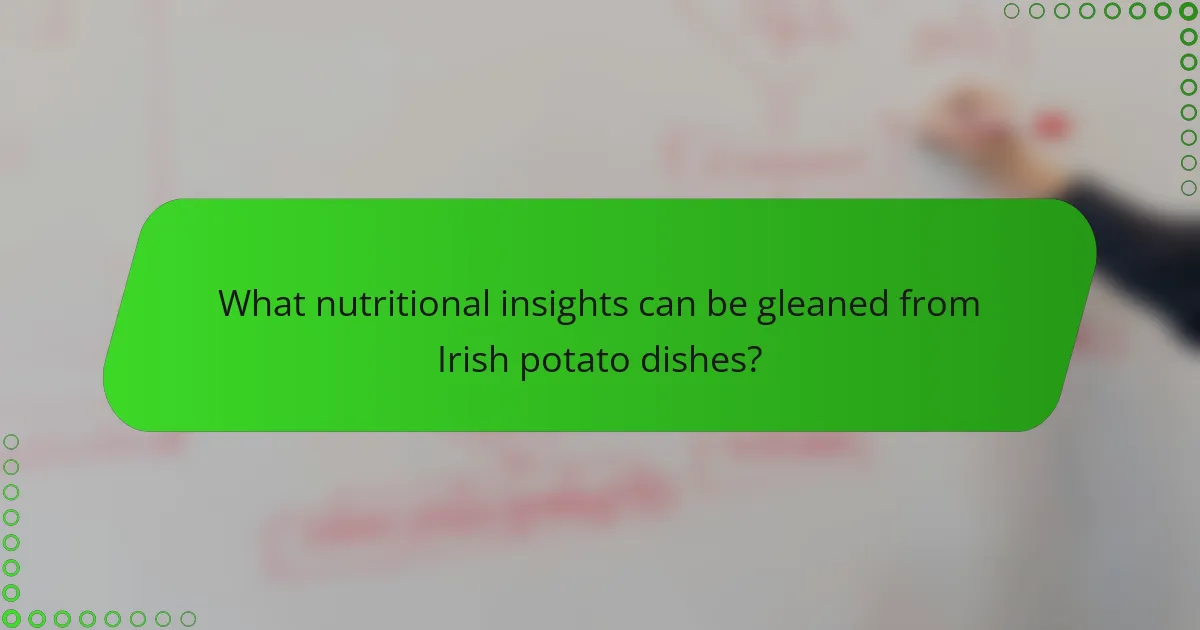
What nutritional insights can be gleaned from Irish potato dishes?
Irish potato dishes are rich in carbohydrates, primarily providing energy. They also contain dietary fiber, which aids digestion. Potatoes are a good source of vitamins, particularly vitamin C and B6. These vitamins support immune function and brain health. Additionally, potatoes provide essential minerals like potassium, which helps regulate blood pressure. The preparation methods can influence nutritional content. Boiling and baking retain more nutrients compared to frying. Overall, Irish potato dishes offer a balanced combination of macronutrients and micronutrients beneficial for health.
What are the health benefits of potatoes in Irish cuisine?
Potatoes in Irish cuisine offer several health benefits. They are a rich source of vitamins and minerals. Potatoes contain vitamin C, which supports immune function. They also provide potassium, essential for heart health. The fiber content in potatoes aids digestion and promotes gut health. Additionally, potatoes are low in calories and fat, making them a healthy carbohydrate choice. Studies show that consuming potatoes can contribute to a balanced diet. Overall, potatoes are a nutritious staple in Irish cuisine.
How do different preparation methods affect the nutritional value of potatoes?
Different preparation methods significantly affect the nutritional value of potatoes. Boiling potatoes retains more vitamins and minerals compared to frying. Boiled potatoes have lower fat content, preserving their natural nutrients. Frying, however, increases calorie and fat content due to added oils. Baking potatoes can enhance their fiber content while keeping calories moderate. Microwaving potatoes is another method that minimizes nutrient loss effectively. Research indicates that boiling can reduce vitamin C levels by 30%, while frying may lead to a 50% increase in fat. Therefore, the chosen cooking method directly impacts the overall nutritional profile of potatoes.
What vitamins and minerals are abundant in traditional Irish potato dishes?
Traditional Irish potato dishes are abundant in vitamins and minerals. Key vitamins include vitamin C, which supports immune function and skin health. Potatoes also provide B vitamins, particularly B6, important for brain health and metabolism.
Minerals found in these dishes include potassium, essential for heart health and muscle function. Iron is also present, crucial for oxygen transport in the blood. Additionally, magnesium contributes to bone health and energy production.
These nutrients are derived from the primary ingredient, potatoes, which are a staple in Irish cuisine. The cooking methods, such as boiling or baking, preserve these vitamins and minerals effectively.
How can Irish potato dishes fit into a balanced diet?
Irish potato dishes can fit into a balanced diet by providing essential nutrients and carbohydrates. Potatoes are rich in vitamins C and B6, potassium, and dietary fiber. Consuming them in moderation contributes to energy needs and satiety. Preparation methods such as boiling, baking, or steaming retain their nutritional value. Pairing potatoes with lean proteins and vegetables enhances overall meal balance. Studies indicate that including potatoes in a diet can support digestive health due to their fiber content. Thus, when prepared healthily, Irish potato dishes can be a nutritious part of a balanced diet.
What portion sizes are recommended for various Irish potato dishes?
Recommended portion sizes for various Irish potato dishes vary based on the dish type. For mashed potatoes, a typical serving is about 200 grams. For boiled or steamed potatoes, a serving size is around 150-200 grams. When it comes to potato wedges, a portion is generally 150 grams. For colcannon, a traditional dish, the serving size is approximately 200 grams. In the case of potato cakes, a serving is usually one to two cakes, depending on size. Lastly, for shepherd’s pie, a recommended portion is about 250 grams. These portion sizes are based on common dietary guidelines and cultural practices in Ireland.
How can you modify traditional recipes for healthier options?
You can modify traditional recipes for healthier options by substituting ingredients and altering cooking methods. Use whole grains instead of refined grains for added fiber. Replace heavy creams with low-fat dairy or plant-based alternatives. Incorporate more vegetables to increase nutrient density. Reduce added sugars by using natural sweeteners like honey or fruit. Opt for lean proteins instead of fatty meats. Use herbs and spices for flavor instead of salt. Cooking methods like baking or steaming are healthier than frying. These changes can significantly lower calorie counts and enhance nutritional value.
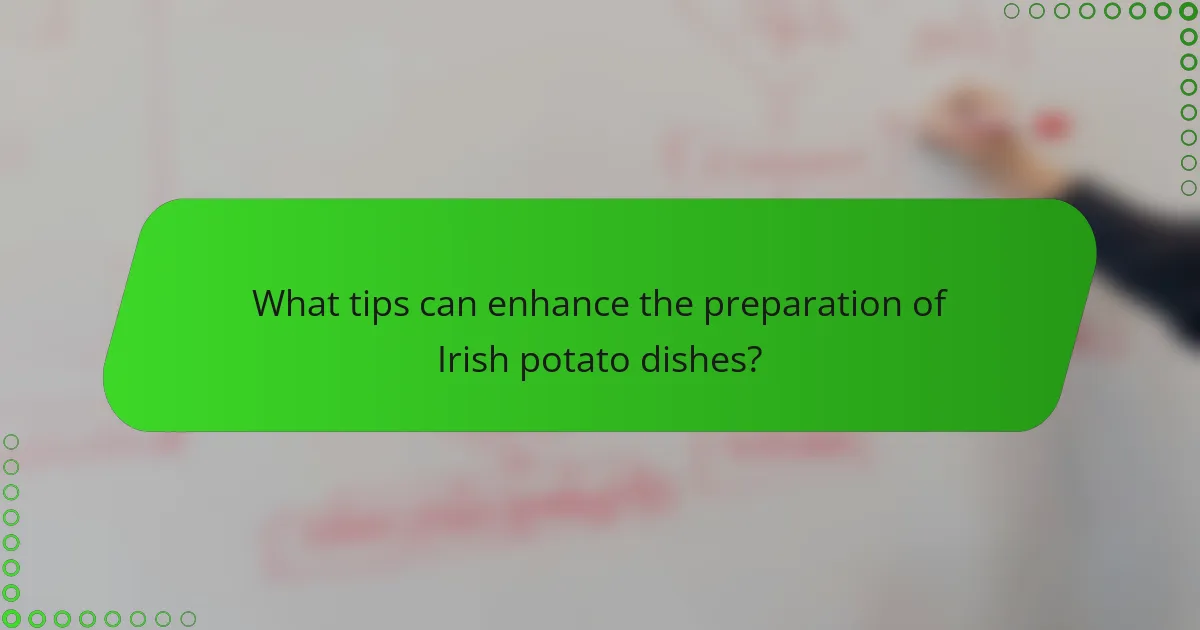
What tips can enhance the preparation of Irish potato dishes?
Use fresh, high-quality potatoes for the best flavor and texture in Irish potato dishes. Choosing varieties like Yukon Gold or Russet enhances creaminess. Properly wash and peel potatoes to remove dirt and pesticides. Cutting potatoes into uniform sizes ensures even cooking. Soaking cut potatoes in cold water removes excess starch, resulting in crispier dishes. Cooking potatoes in salted water enhances their natural flavor. Avoid overcooking to maintain a firm texture. Finally, incorporating herbs like parsley or chives adds freshness and complexity to the dish.
What common mistakes should be avoided when preparing Irish potato dishes?
Common mistakes to avoid when preparing Irish potato dishes include overcooking the potatoes. Overcooking leads to a mushy texture and loss of flavor. Another mistake is using the wrong type of potato. Starchy potatoes like Russets are best for mashing, while waxy varieties suit boiling. Neglecting to season properly can result in bland dishes. It’s also essential to avoid cutting potatoes too small, as this can cause uneven cooking. Lastly, not allowing potatoes to cool before mashing can lead to gummy results. These practices can significantly affect the quality and taste of Irish potato dishes.
How can you achieve the perfect texture in mashed potatoes?
To achieve the perfect texture in mashed potatoes, start with the right potato variety. Starchy potatoes, like Russets or Yukon Golds, create a fluffy texture. Boil the potatoes until tender but not waterlogged. Drain them thoroughly to remove excess moisture. Use a potato ricer or masher for a smooth consistency. Avoid using a food processor, as it can make the potatoes gummy. Incorporate warm milk or cream gradually to achieve creaminess. Add softened butter for richness and flavor. Season with salt to enhance taste. Each step contributes to the desired texture and flavor profile of the dish.
What are some creative variations to try with traditional recipes?
Creative variations for traditional Irish potato dishes include using sweet potatoes instead of regular potatoes. This adds a different flavor profile and nutritional benefits. Another variation is incorporating herbs like rosemary or thyme for enhanced aroma and taste. Adding cheese, such as cheddar or feta, can introduce a creamy texture.
Experimenting with spices like paprika or cumin can also provide a unique twist. Using different cooking methods, such as roasting instead of boiling, creates varied textures. Combining potatoes with other vegetables, like carrots or parsnips, can add color and nutrients.
Finally, serving potatoes with unique sauces, such as pesto or curry, can elevate the dish. These variations maintain the essence of traditional recipes while introducing new flavors and textures.
The main entity of the article is Irish potato dishes, which are characterized by their simplicity, heartiness, and versatility. The article provides an in-depth exploration of various preparation methods, including boiling, mashing, and baking, along with traditional recipes like colcannon and boxty. It also highlights regional variations across Ireland, the cultural significance of these dishes, and the nutritional insights associated with potatoes. Additionally, the article discusses common cooking techniques, complementary ingredients, and tips for enhancing the preparation of Irish potato dishes, ensuring a comprehensive understanding of this staple in Irish cuisine.
